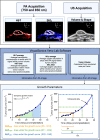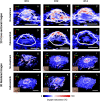3D Ultrasound-Guided Photoacoustic Imaging to Monitor the Effects of Suboptimal Tyrosine Kinase Inhibitor Therapy in Pancreatic Tumors
- PMID: 35875138
- PMCID: PMC9300843
- DOI: 10.3389/fonc.2022.915319
3D Ultrasound-Guided Photoacoustic Imaging to Monitor the Effects of Suboptimal Tyrosine Kinase Inhibitor Therapy in Pancreatic Tumors
Abstract
Pancreatic cancer is a disease with an incredibly poor survival rate. As only about 20% of patients are eligible for surgical resection, neoadjuvant treatments that can relieve symptoms and shrink tumors for surgical resection become critical. Many forms of treatments rely on increased vulnerability of cancerous cells, but tumors or regions within the tumors that may be hypoxic could be drug resistant. Particularly for neoadjuvant therapies such as the tyrosine kinase inhibitors utilized to shrink tumors, it is critical to monitor changes in vascular function and hypoxia to predict treatment efficacy. Current clinical imaging modalities used to obtain structural and functional information regarding hypoxia or oxygen saturation (StO2) do not provide sufficient depth penetration or require the use of exogenous contrast agents. Recently, ultrasound-guided photoacoustic imaging (US-PAI) has garnered significant popularity, as it can noninvasively provide multiparametric information on tumor vasculature and function without the need for contrast agents. Here, we built upon existing literature on US-PAI and demonstrate the importance of changes in StO2 values to predict treatment response, particularly tumor growth rate, when the outcomes are suboptimal. Specifically, we image xenograft mouse models of pancreatic adenocarcinoma treated with suboptimal doses of a tyrosine kinase inhibitor cabozantinib. We utilize the US-PAI data to develop a multivariate regression model that demonstrates that a therapy-induced reduction in tumor growth rate can be predicted with 100% positive predictive power and a moderate (58.33%) negative predictive power when a combination of pretreatment tumor volume and changes in StO2 values pretreatment and immediately posttreatment was employed. Overall, our study indicates that US-PAI has the potential to provide label-free surrogate imaging biomarkers that can predict tumor growth rate in suboptimal therapy.
Keywords: blood oxygen saturation; hypoxia; neoadjuvant therapy; pancreatic cancer; photoacoustic imaging; suboptimal therapy; treatment prediction; tyrosine kinase inhibitor.
Copyright © 2022 Claus, Sweeney, Sankepalle, Li, Wong, Xavierselvan and Mallidi.
Conflict of interest statement
The authors declare that the research was conducted in the absence of any commercial or financial relationships that could be construed as a potential conflict of interest.
Figures









Similar articles
-
Prediction of tumor recurrence and therapy monitoring using ultrasound-guided photoacoustic imaging.Theranostics. 2015 Jan 1;5(3):289-301. doi: 10.7150/thno.10155. eCollection 2015. Theranostics. 2015. PMID: 25553116 Free PMC article.
-
Photoacoustic Imaging as an Early Biomarker of Radio Therapeutic Efficacy in Head and Neck Cancer.Theranostics. 2018 Mar 6;8(8):2064-2078. doi: 10.7150/thno.21708. eCollection 2018. Theranostics. 2018. PMID: 29721063 Free PMC article.
-
Vascular regional analysis unveils differential responses to anti-angiogenic therapy in pancreatic xenografts through macroscopic photoacoustic imaging.bioRxiv [Preprint]. 2024 Jun 1:2024.05.27.595784. doi: 10.1101/2024.05.27.595784. bioRxiv. 2024. Update in: Theranostics. 2025 Jan 27;15(6):2649-2671. doi: 10.7150/thno.99361. PMID: 38854042 Free PMC article. Updated. Preprint.
-
Review on Photoacoustic Monitoring after Drug Delivery: From Label-Free Biomarkers to Pharmacokinetics Agents.Pharmaceutics. 2024 Sep 24;16(10):1240. doi: 10.3390/pharmaceutics16101240. Pharmaceutics. 2024. PMID: 39458572 Free PMC article. Review.
-
Photoacoustic Imaging in Tissue Engineering and Regenerative Medicine.Tissue Eng Part B Rev. 2020 Feb;26(1):79-102. doi: 10.1089/ten.TEB.2019.0296. Epub 2020 Jan 14. Tissue Eng Part B Rev. 2020. PMID: 31854242 Free PMC article. Review.
Cited by
-
Ultrasound-guided Photoacoustic image Annotation Toolkit in MATLAB (PHANTOM) for preclinical applications.bioRxiv [Preprint]. 2023 Nov 10:2023.11.07.565885. doi: 10.1101/2023.11.07.565885. bioRxiv. 2023. Update in: Photoacoustics. 2024 Nov 09;41:100662. doi: 10.1016/j.pacs.2024.100662. PMID: 37986998 Free PMC article. Updated. Preprint.
-
Niche preclinical and clinical applications of photoacoustic imaging with endogenous contrast.Photoacoustics. 2023 Jul 17;32:100533. doi: 10.1016/j.pacs.2023.100533. eCollection 2023 Aug. Photoacoustics. 2023. PMID: 37636547 Free PMC article. Review.
-
Vascular regional analysis unveils differential responses to anti-angiogenic therapy in pancreatic xenografts through macroscopic photoacoustic imaging.Theranostics. 2025 Jan 27;15(6):2649-2671. doi: 10.7150/thno.99361. eCollection 2025. Theranostics. 2025. PMID: 39990229 Free PMC article.
-
In Vivo Ultrasound and Photoacoustic Imaging of Nanoparticle-Engineered T Cells and Post-Treatment Assessment to Guide Adoptive Cell Immunotherapy.ACS Nano. 2025 Feb 18;19(6):6079-6094. doi: 10.1021/acsnano.4c12929. Epub 2025 Feb 5. ACS Nano. 2025. PMID: 39908484 Free PMC article.
-
In vivo, online label-free monitoring of heterogenous oxygen utilization during phototherapy with real-time ultrasound-guided photoacoustic imaging.bioRxiv [Preprint]. 2024 Dec 3:2024.11.27.625759. doi: 10.1101/2024.11.27.625759. bioRxiv. 2024. PMID: 39677615 Free PMC article. Preprint.
References
Grants and funding
LinkOut - more resources
Full Text Sources
Research Materials

